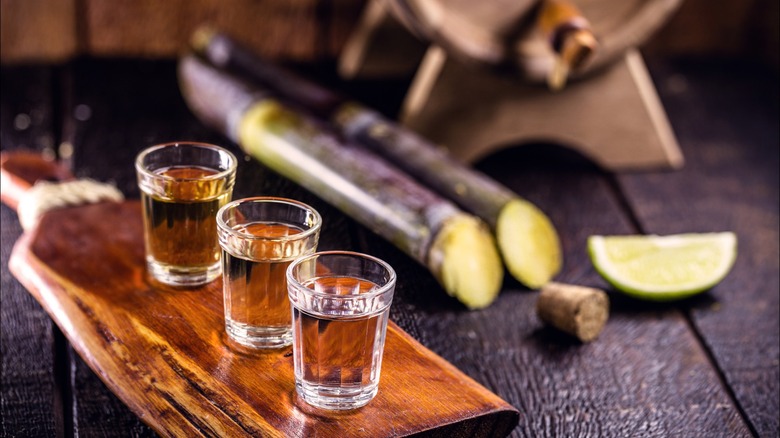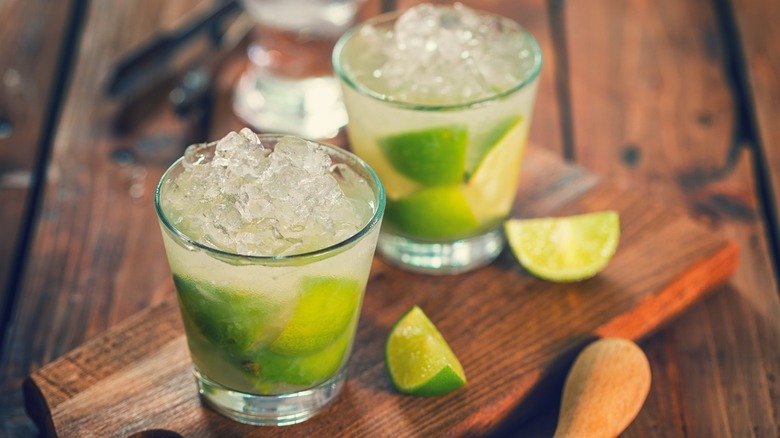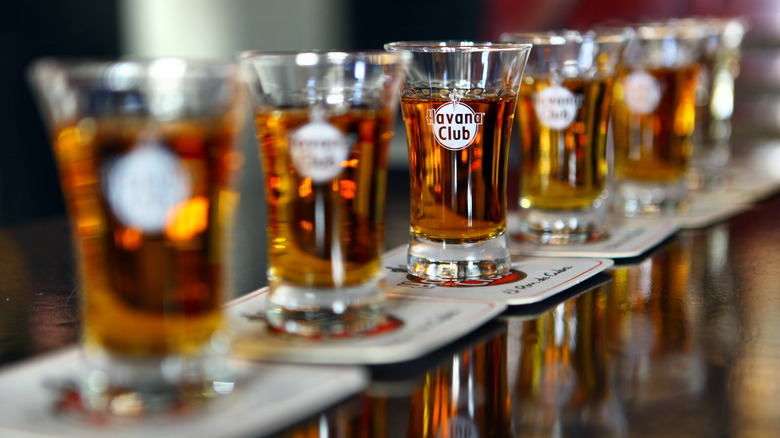What's The Difference Between Cachaça And Rum?
Rum is one of the most well-known and widely consumed liquors around. Whether you want to sip on a tart daiquiri or a tropical hurricane, or even if you want a sophisticated spirit-forward cocktail, there's a rum out there that's fit for the occasion. Its variability and approachability has made rum a beloved spirit among novices and enthusiasts alike, and there's little doubt that you're quite familiar with rum if you're a liquor connoisseur. But how familiar are you with Brazil's distilled pride and joy, cachaça? Some may say that it's an alternative for rum and that they can be swapped interchangeably, but those people would be far from correct. Cachaça and rum certainly have similarities -– but don't be mistaken, they're both two totally distinct spirits. So, what is the difference exactly, and just how different are they?
Most misconceptions around cachaça and rum revolve around the fact that both South American-made liquors are produced from sugar of some kind and can look quite similar. However, that's about where their likenesses end. The simple difference is that though both spirits are made from a sugar product, cachaça is distilled from fresh cane juice, while rum is made from distilled sugarcane of whatever variety (hence the vast variability of the liquor). So, while you could technically argue that cachaça can be considered a type of rum, that would be an injustice to the history and cultural importance of cachaça in Brazil, not to mention the flavor differences.
Cachaça is a predecessor of rum
During the European colonization of the Americas, sugar was a red-hot commodity among Spanish and Portuguese sailors. Sugar plantations popped up all over the region of modern-day Brazil, with the first one of its kind appearing in 1504 and the first on-record sugarcane mill following in 1516. And it didn't take too much time before these sugar-processing facilities also began creating a prototypical version of what is now cachaça. Made by distilling uncooked sugarcane juice, cachaça is quite a simple method of liquor distillation — even contemporary cachaça producers use the same centuries-old methods to produce cachaça due to its rather rustic but uncomplicated process. Over time, cachaça has become so ingrained in Brazilian culture that, now, cachaça can only be made in the country that birthed it.
In terms of taste, the fact that cachaça is made from uncooked cane juice plays a huge role in distinguishing it from other sugar-based spirits. As such, its rawer base means that cachaça tends to be more purely sweet compared to rum. Cachaça can be bottled right after its distillation is complete or it can be aged in wooden casks for at least one year. One really interesting tidbit is that, while many spirits have a strict rule for which woods to use for aging, you can find cachaça aged from many different woods, including several which are native to Brazil. Though most common in a caipirinha, this cocktail only scratches the surface of how you can enjoy cachaça.
Rum is made from a litany of sugar products
Sometimes it can be hard to nail down exactly what rum is made of, because there's a high degree of variability concerning what goes in rum to begin with. While the spirit can be made from sugarcane juice just like cachaça (as is the case with rhum agricole), it's much more common for rum to be made from a byproduct of sugar, such as molasses or cane syrup. There's even a degree of variability when it comes to the physical equipment used in distilling sugar products into what will become rum, with different types of stills being used by different distillers. These two factors combine to produce a vast array of rums — and that doesn't even account for the aging process that many rums undergo. The result of all of this is a variety of rums that range from clear to dark, from mildly sweet to deeply molasses-like, and everything in-between.
Of course, this means that not all rums are created equal and, accordingly, that some rums are best left on the liquor store shelf. But a good rum can serve you well in cocktails, or even served neat if you prefer. It's also a common practice to blend rums in cocktails due to the sheer diversity in the flavors of different rums. So, perhaps it's your wisest move to simply grab a selection of bottles of both cachaça and rum, and taste all the wonderful differences for yourself.


